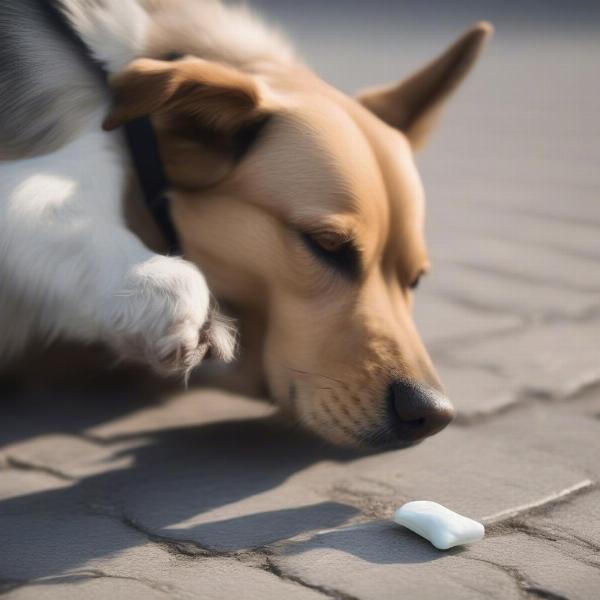If your dog snagged a piece of discarded chewing gum, you’re probably wondering if it’s a cause for concern. While a small amount of gum isn’t usually toxic, it can cause digestive upset and, in rare cases, more serious complications. This article will guide you through what to expect if your dog eats chewed gum, what the potential risks are, and what you should do.
Chewing gum’s main ingredient is gum base, which isn’t digestible. While this in itself isn’t typically toxic to dogs, the problem arises from the other ingredients like sweeteners, flavorings, and preservatives. Xylitol, a common artificial sweetener, is particularly dangerous for dogs. Even small amounts can cause a rapid drop in blood sugar (hypoglycemia), leading to weakness, seizures, liver failure, and even death. If the gum your dog ate contained xylitol, contact your veterinarian immediately.
Is Chewing Gum Toxic to Dogs?
The toxicity of chewing gum for dogs depends largely on the ingredients and the amount ingested. Most chewing gums contain gum base, which is indigestible. This means it won’t be broken down in your dog’s stomach and will pass through their system. However, this can still pose some risks, particularly if your dog swallows a large wad of gum. It could cause a blockage in their digestive tract, leading to constipation or, in severe cases, requiring surgery.
 Dog eating chewed gum
Dog eating chewed gum
Another key concern is the sweeteners used in chewing gum. While some gums use sugar, which isn’t ideal for dogs, the more significant danger comes from artificial sweeteners, especially xylitol. Xylitol is highly toxic to dogs and can cause a rapid release of insulin, leading to a dangerous drop in blood sugar. This can result in symptoms like weakness, lethargy, vomiting, seizures, liver failure, and even death. If you suspect your dog has ingested xylitol-containing gum, seek immediate veterinary attention.
Symptoms of Xylitol Poisoning in Dogs
If your dog consumed gum containing xylitol, watch for these symptoms:
- Weakness and Lethargy: Your dog might seem unusually tired and reluctant to move.
- Vomiting: One of the most common signs of xylitol poisoning.
- Loss of Coordination: Your dog may stumble or have difficulty walking.
- Tremors or Seizures: These are serious signs of xylitol toxicity.
- Jaundice (yellowing of the gums and whites of the eyes): Indicates liver damage.
What to Do if Your Dog Eats Chewed Gum
If your dog eats chewing gum, the first step is to identify the type of gum and its ingredients. If the gum contains xylitol, contact your veterinarian or an animal poison control center immediately. Time is of the essence in cases of xylitol poisoning. Even if the gum doesn’t contain xylitol, it’s wise to monitor your dog for any signs of digestive upset, such as vomiting, diarrhea, loss of appetite, or abdominal pain.
How to Prevent Your Dog from Eating Chewed Gum
The best way to prevent your dog from eating chewing gum is to be mindful of where you dispose of it. Make sure it’s securely placed in a trash can that your dog can’t access. When out on walks, be vigilant about your dog picking up discarded gum from the street. Training your dog to “leave it” can also be helpful in these situations.
Conclusion
While a small amount of sugar-free gum without xylitol might not cause serious harm, it’s crucial to avoid letting your dog consume any chewing gum. The potential risks, particularly with xylitol-containing gums, are simply too significant. Be vigilant about proper disposal and train your dog to avoid picking up things off the ground. If your dog ingests gum with xylitol, immediate veterinary intervention is critical.
FAQ
- Is all sugar-free gum toxic to dogs? Not all, but many contain xylitol, which is highly toxic. Always check the ingredients.
- Can a small piece of gum hurt my dog? Even a small piece of xylitol-containing gum can be dangerous.
- How long does it take for xylitol poisoning to show symptoms? Symptoms can appear within 15-30 minutes of ingestion.
- What is the treatment for xylitol poisoning? Treatment may include inducing vomiting, administering activated charcoal, and intravenous fluids to stabilize blood sugar and support liver function.
- How can I train my dog to “leave it”? This involves using positive reinforcement to teach your dog to ignore items on the ground. Consult a professional dog trainer for guidance.
- What if my dog ate gum but seems fine? Even if your dog seems fine, it’s always best to contact your vet, especially if you don’t know the ingredients of the gum.
- Can chewing gum cause a bowel obstruction in dogs? Large wads of gum can potentially cause blockages, especially in smaller dogs.
ILM Dog is your trusted source for expert advice on dog care and wellbeing. We offer a wide range of resources, from breed selection and puppy care to senior dog care and training tips. Whether you’re a new dog owner or a seasoned pro, ILM Dog has the information you need to help your furry friend thrive. For expert advice on dog breeds, health, nutrition, training, and more, visit us at https://ilmdog.com. Contact us at [email protected] or call +44 20-3965-8624.